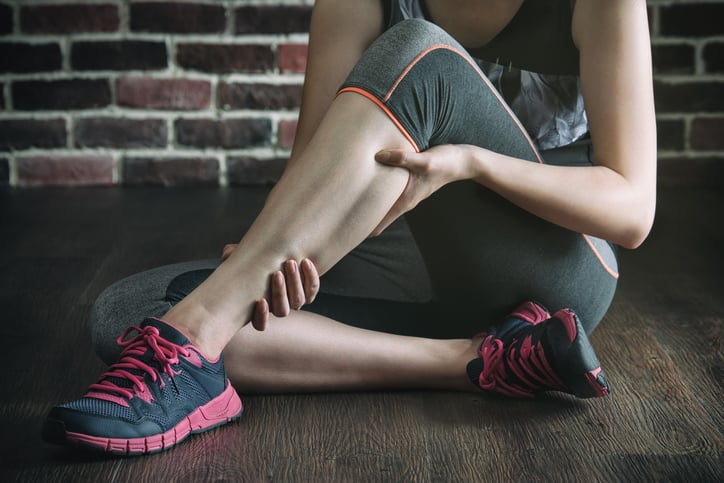How to Combat Muscle Cramps (8 simple tricks)

We’ve all dealt with muscle cramps at some time or another, but did you ever stop to consider the causes of cramping in the first place and what you can do to prevent them?
First, it might be a good idea to narrow down what, exactly, a muscle cramp is anyway. According to Pub Med, a free online medical resource, muscle cramps are very common and are generally distinguished by a sudden onset of involuntary muscle contraction or spasm. They can be quite painful and can last anywhere from a few seconds to a few hours. Often, they are debilitating, and while they’re happening, you may not even be able to move.
Pain, stitch, spasm, cramp, twitch, charley horse… whatever you call it, the bottom line is that your muscles are cramping up. You know you’re in pain, but why does this cramp feel different from the last one you experienced? Are there different kinds of muscle cramps?
In short, yes. There are different types of cramps, and they can occur in both smooth muscle and skeletal muscle. Some may be exercise-induced while others can be due to a variety or even a combination of different factors. Here are the four main cramp distinctions:
- True cramps
- Tetany
- Contractures
- Dystonic
“True cramps” are the most common and tend to involve a specific body part like your foot or part of your hand. These can be caused by exercising a little bit too hard or not resting enough and thus overexerting yourself. They can also occur during sleep, like the all-too-familiar charley horse. Sometimes, sleeping in an awkward position is enough to set yourself up for one of these cramps.
A “tetany” cramp is a spasming of all your muscles due to the nerves in your body being disrupted. This can happen for many different reasons including the presence of toxins in the body or even an imbalance in electrolytes or nutrients.
“Dystonic cramps” may not be as painful and may look more like a twitch, like an eye twitch, a hand cramp, or a clenching of your jaw. These tend to be experienced in smaller muscle groups and may be caused by repetitive motions resulting in overuse, and thus, spasms.
“Contracture cramping” is caused by scar tissue and tends to prevent the muscles from functioning and moving as they should. These cramps are, thankfully, less common than the other types of cramps. However, these could signal deeper medical issues, and it’s a good idea to check with your physician to ensure they’re not part of a bigger health problem.
Major Causes of Muscle Cramps
Which factors can cause the dreaded muscle cramps? There are myriad causes. Here’s a dive into some of the most common reasons your muscles may be cramping:
• Poor circulation—this is a condition that affects you negatively in so many ways, and cramping may be one result.
• Not enough stretching—working muscles that are already shortened, tense, and inflexible is a recipe for disaster.
• Lack of flexibility—as mentioned above, just being inflexible can be the catalyst to cramping.
• Medications—you never know, but some medications you may be taking could even be the culprits when it comes to muscle spasms and pain. Check with your doctor and see if there are any likely offenders in your daily prescription lineup.
• Not enough nutrients—your body needs vitamins and minerals to function, as well as the macronutrients: protein, carbohydrates, and fats. If you skip food groups or don’t get the nutrients your body requires, you’re setting yourself up for issues, including muscle cramps.
• Lack of electrolytes—when you exercise, sweat, get overheated, or otherwise lose fluids, you can upset the delicate balance of these vital nutrients. An electrolyte imbalance can cause a litany of health issues which can include either weak muscles or muscles which contract too severely, causing cramping.
• Overexertion—trying to push yourself too hard can cause your muscle to rebel. A cramp can be a shout out from your body telling you to ease up and give it a rest.
• A history of muscle cramps—a 2015 study cited on the National Center for Biotechnology Information website stated that having a history of muscle cramps can lead to a greater-than-average number of muscle cramps in the future. So, it does seem to show that some folks are more prone to muscle cramps than others, or that previous injury or etiology could contribute to a greater risk of future cramping.
With all that said, what in the world can you do to prevent these painful occurrences in the first place?
How to Prevent Muscle Cramps
It stands to reason that if the above items cause muscle cramping, then you probably want to do the exact opposite of what causes them, correct? Here are some methods to prevent cramping from occurring to begin with.
• Cool downs—these are probably just as important as warming up. You’re warmed up and you’ve been going strong, and then all of the sudden, you just stop what you’re doing. Your muscles are much more likely to remain calm if you slowly bring your body back down to normal function with another short, slower walk on the treadmill or some muscle-specific stretching and cool down exercises to engage the body part(s) you were just working.
• Proper nutrition—as always, it’s important to get the right vitamins, minerals, and nutrients your body needs to replenish and heal itself. Magnesium, zinc, vitamins B, D, and E are all vital when it comes to smooth functioning muscles.
• Stretching—as mentioned above, stretching is a great way to engage your muscles without putting undue stress upon them.
• Drink water—drink throughout your day and definitely before, during, and after your workout. It’s important to stay hydrated. Avoid diuretics and make sure you keep some sodium in your diet, too, if you’re prone to cramping. It’s not helpful to drink water, but sweat it all out at the gym.
• Go bananas—a medium-sized banana has a little over 400 mg of potassium and is a good start toward providing your body with the nutrients it needs to prevent cramps.
• Don’t overdo it—always make sure to push yourself, but not too far. Use progressive training to make gains over time instead of trying to suddenly go from a light jog to running a marathon. Take time to build up endurance and strength so your muscles, tendons, and ligaments can acclimate and get stronger over time.
• Maintain your electrolyte balance—that means keeping potassium, sodium and chloride, calcium, magnesium, and phosphate (electrolytes) in sufficient supply. Make sure you eat a varied diet of fresh, natural whole foods, including plenty of fresh fruits and vegetables. If you exercise strenuously, you can also replenish with a sports drink or coconut water.
How to Stop a Muscle Cramp Once It Starts
Now, if you aren’t able to prevent the muscle cramp, and you do end up getting one (this often happens when people sleep), what should you do?
• Ice—is almost always a great remedy for what ails you. Icing the affected area can help the muscles and over-excited nerves “calm down.”
• Anti-inflammatories—these can be somewhat helpful, after the fact, in terms of reducing swelling and relax the nerves and muscles in the area.
• Give it a rest—this is probably an obvious one, but it could be overlooked as being much too simple to be effective. If you’ve been overusing a muscle or group of muscles and haven’t gotten sufficient nutrition, hydration, and stretching, you most likely need to lighten up a bit and give your muscles some downtime.
Now, you know the secrets to help you prevent muscle cramping, and what to do if you do experience a cramp. A muscle cramp here and there is a normal part of life, but do remember, if they become more frequent, it may be time for a visit to your physician. But, with proper nutrition, supplementation, rest, and stretching, you’ll be doing your best to maintain an environment that won’t cramp your lifestyle.






